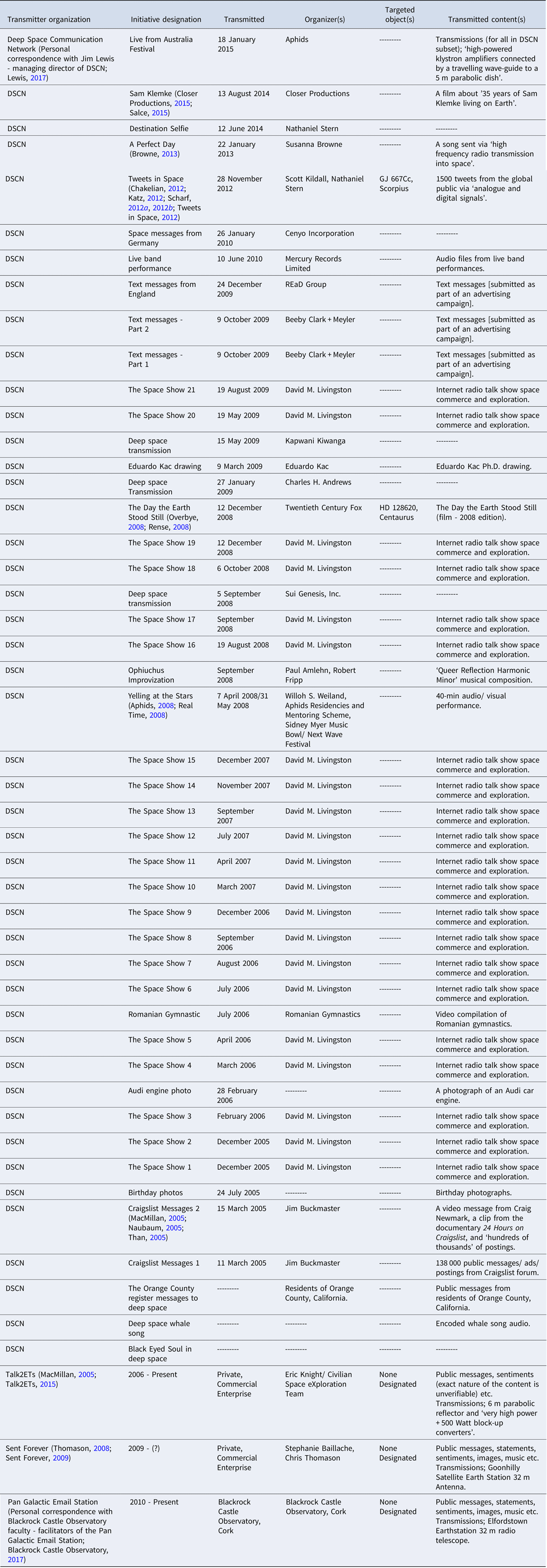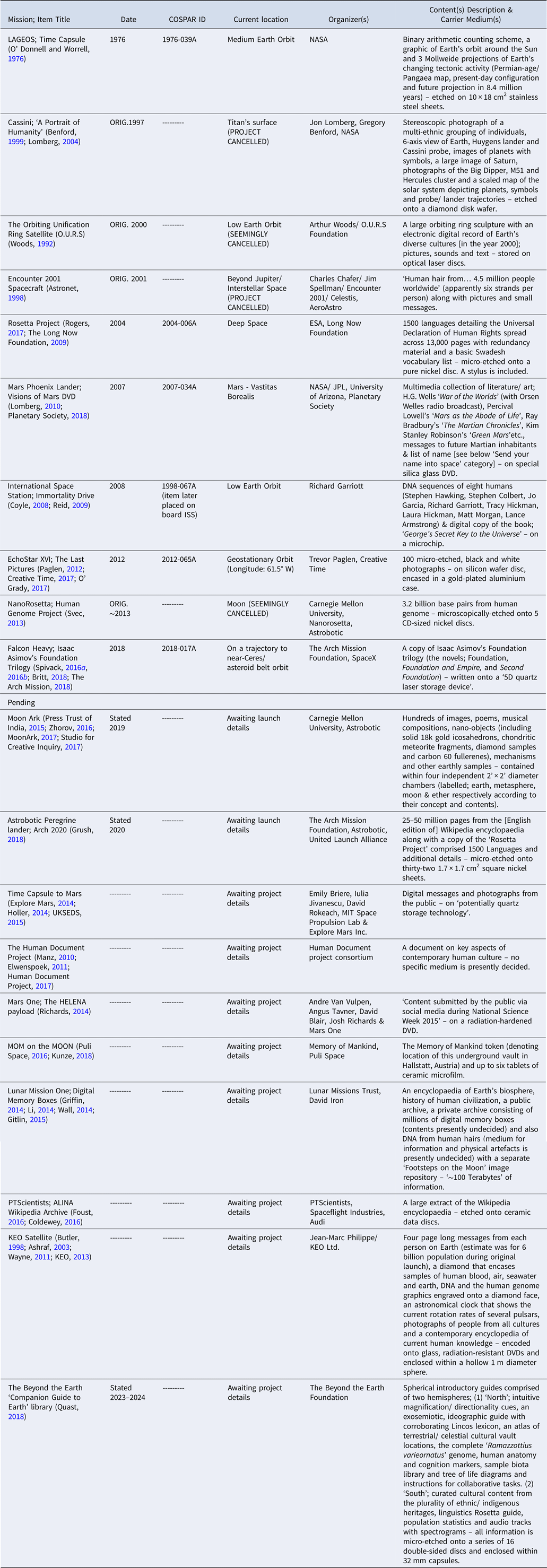Overview
The cultural signature of humanity is a fluctuating, artificial field of intelligent design that [unevenly] emanates outwards from our planet as a result of the many pioneering initiatives we have engineered to preserve the abstract, cognitive reasoning of our species [and its prolific exploration of the cosmos]. There are many applications that presently contribute to this purposeful, celestial property of the Earth; our desires to create secure ‘eternal memory’ libraries to preserve information beyond our terrestrial environment (Guzman et al., Reference Guzman, Welch and Hein2015), communication attempts with extra-terrestrial intelligence (Zaitsev, Reference Zaitsev2006), expressions within ‘SpaceArt’ (Paglen, Reference Paglen2012), mission outreach initiatives (Sutherland, Reference Sutherland2015) and also symbolic gestures (Schulze-Makuch, Reference Schulze-Makuch2016) devised to impart some profound heuristic about our observed position within the universe. However, considering the present criticism associated within Messaging to Extra-Terrestrial Intelligence (METI) and the ongoing controversy of a priora transmission strategies (Billingham and Benford, Reference Billingham and Benford2011; Brin, Reference Brin2014; Gertz, Reference Gertz2016), it is vital that we should also responsibly contextualize all of our envoys [including physical artefacts and memoranda items that are capable of reaching other minds beyond the temporal horizon] and examine how they could collectively define the anthropocentric ‘voice’ of our world – or, in the very least, to keep track of the many narratives and philosophies we employ in describing our planet and its resident human population.
Presently, there is no consolidated inventory of the numerous multifaceted ‘technomarker’ activities that define our world at a distance other than several assessments [of our radio messages] performed by the Search for Extra-Terrestrial Intelligence (SETI) and METI communities (Vakoch, Reference Vakoch2009; Zaitsev, Reference Zaitsev2012; Dumas, Reference Dumas2015) who responsibly document intelligible, electromagnetic envoys that intend to initiate diplomatic relations on behalf of Earth's populace over intervals of deep time. In the absence of this centralized index, we currently possess many disparate accounts that cite singular events or references of unsubstantiated, ‘weird’ materials (Chilton, Reference Chilton2016) which could presently provide a unilateral impression of our planet. Due to this, accurately assessing humanities’ extended sphere of influence is particularly difficult as we cannot reasonably articulate the role of a number of frequent, inimical concerns that could be inherent within these relics including;
• The aggregate of these objects and messages may provide an ethnically-biased perspective of our planet – omitting many cultures and indigenous communities in favour of populations who speak louder than others.
• Content chosen as an emissary of Earth might not democratically reflect our planet and may be partial towards the ideologies established by hegemonic populations – a subset of our shared global society.
• Information conveyed by numerous activities may subsequently contradict other sources thus providing incoherent documentation that could be disruptive for the receivers’ [archaeological] deductions.
• This material may be unintelligible to a future recipient if we do not render concepts into comprehendible frameworks to aid in interpretation – an issue that could be inelegant at best or irresponsible at worst.
• We cannot deduce or evaluate what ‘metamessage’ (Saint-Gelais, Reference Saint-Gelais and Vakoch2014) information could have been conveyed to a receiver.
In line with prior surveys of METI signals and also the intricate registry produced by the Olgethorpe Universities’ International Time Capsule Society (Oglethorpe University, 1990), the below catalogue is presented as a work-in-progress directory to document the celestial legacy of our civilization beyond Earth's borders. This index has been established in order to; consolidate and classify the information that could come to collectively define our generation(s) and the Earth system it inhabits, provide unique support material for an impending, phased publication that will theorise about the present perception(s) of Earth (the premise will be based upon the hypothetical acquisition of segments/all available spatial resources by dissimilar agents) and also to contribute to the development of ethical guidelines in line with other emergent fields that stand to influence our planet's indelible legacy. It is anticipated that the established categories and overall framework of this directory will be updated over time as sustained research, peer contributions and future initiatives elucidate the anthropogenic signature emanating from Earth on behalf of all terrestrial life and its’ future descendants.
Notes
The principle, common criterion for all of the below listings is that the stated information will be accessible in space and remain accessible in some capacity over moderate to extended periods of time. Some past/forthcoming initiatives have also been included to document these impending activities for communal review. The below catalogue is divided into a series of subcategories based predominately upon; the medium used to convey this information beyond Earth's atmosphere, the identified/detailed purpose of the activity (extra-terrestrial/descendant communication, information-storage, symbolic event, mission outreach etc.) and also whether these artefacts and transmission events can intelligibly fulfil their stated criteria (e.g. communicating with our descendants while also compensating for social evolution over protracted time frames). These listings only detail artefacts that have/will not returned to Earth and do not feature mission-orientated infrastructure (e.g. satellite communications, physical probes, launch vehicles, scientific payloads) or the radiosphere i.e. the unintentional field of electromagnetic ‘leakage’ emanating from terrestrial technologies.
This catalogue has been assembled in the interest of quantifying the range of cultural property that presently resides within space in order to provide support data for further academic study and communal research. A substantial portion of the information detailed below has been gathered through the kind support of the various individuals, institutes, organizations and other entities who have contributed to this biogenic signature of Earth. Some fields within each subcategory are marked with ‘---------’ to denote lacunae and all activities are listed chronologically in CE notation.
METI interstellar radio messages
This category is largely defined by scholars within the SETI community who classify the below Active SETI transmission events under a number of set criteria including; relevant selection of signal target(s), adequate signal properties necessary to transverse the interstellar medium in order to be detected by an extra-terrestrial receiving array, appropriate modulation techniques that could theoretically be accessible for an Extra-Terrestrial Intelligence (ETI) and also selective content which denotes ideologies that should be comprehendible for extrasolar denizens. Furthermore, these messages also score high on the San Marino Scale (Almár and Shuch, Reference Almár and Shuch2006); a metric range used to assess the risks associated with deliberate transmissions from Earth to other civilizations.
Note: ‘Arrival’ field denotes the estimated CE date for each signal to physically reach their stated target(s) – based upon widely-accepted, parallax measurements. This does not, however, delineate whether the signal contents will arrive in a legible manner or as recognizable packets of energy per unit of receiver surface area.

Outreach, educational and symbolic transmissions
This category details signals that are not regarded (by the majority of the mainstream SETI community) as a serious communication attempt with ETI civilizations but rather as symbolic gestures, outreach activities or educational opportunities. Some METI transmissions are listed within this category based upon the extent of criticism from SETI scholars under the criteria; choice of target(s), signal properties, appropriate transmission equipment used, accessibility of contents, lack of encoding methods employed within the signal design etc.

Space mission outreach (transmissions to probes)
This category encompasses transmissions that are intended as public engagement activities for specific space missions or indirect [non-operation function] signals sent specifically to spacecraft.

Cultural expression and advertisement messages
Category details transmissions which are commercial in nature (i.e. advertisement campaigns) or poetic messages that are predominately orientated as expressions of cultural articulation (or ‘SpaceArt’). Signals within this category are also identified based upon criticism and criteria posed by the SETI community.

Short-Range, commercial transmissions
This category details commercial entities that transmit public content into space for a fee or as part of local outreach. Contents of signals placed within this category should not be decipherable past 1 ≤ pc (1- 3ly) from Earth and possess an eclectic range of themes that may not be properly encoded for any of the above applications.

Human time capsules and external memory initiatives
This category details informative, ‘eternal memory’ initiatives and physical time capsule elements that may be largely accessible for future human agents. These initiatives provide a modest to elaborative quantity of intelligible information (assertion is predicated upon discovery by future humans with similar cognitive and morphological functions) with some objects capable of compensating for predicted shifts in cultural evolution on Earth over protracted intervals of time.

Passive METI initiatives
Artefacts within this category are intended as ‘Rosetta stones’ for intercepting ETI and are capable of providing a comprehendible (and in some cases limited) account of life on Earth for another intelligent civilization which may not share our sensory perceptions, morphology, genetic heredity, ontogenic or phylogenetic traits, mutually-experienced environment or cognitive capabilities.

Space mission publicity and outreach initiatives
Initiatives within this category are identified as part of the publicity and educational activities for a featured space mission and also by the esoteric content included aboard these spacecraft. Most of the items within this category have been organized through outreach activities within numerous space agencies or have been the result of collaborative engagement between organizations.

‘Send your name into space’ initiatives
This category details the popular ‘send your name into space’ outreach initiatives that are conducted by space agencies for either the global public or select groups of individuals/organizations (e.g. The Planetary Society).

Other objects beyond Low Earth Orbit
This category documents the various objects that are present within space which are capable of providing a limited perception of our cultural articulation beyond Earth's atmosphere including; unsanctioned objects left by manned space mission, novelty items inserted into Earth orbit, other tactile elements and also SpaceArt initiatives that presently still reside within this celestial environment.

Acknowledgements
The author would like to thank Carl Walker and Mark McCaughrean (both ESTEC) for providing an intricate account of European Space Agency activities that have contributed to the cultural signature of Earth alongside Shin-ya Narusawa (JAXA Messages), Alexander Zaitsev (Cosmic Call 1&2, Teen Age Message), Jim Lewis (Deep Space Communications Network), Jacob Haqq-Misra (Lone Signal), Jon Lomberg (Voyager 1 & 2 Records, One Earth Message and other projects), Alan Penny (METI International), Daniela de Paulis (Cogito) and also the staff at the Blackrock Castle Observatory (Cork) for facilitating access to their message [content] records for this catalogue. The author would also like to thank David Brin, Gregory Benford and Duncan Forgan for their invaluable input and guiding comments to maintain the accuracy of this index. Finally, the author would also like to acknowledge the SETI/ METI communities for their sustained investigations to classify off-world transmission events. This catalogue would have taken far longer to compile had it not been for their sustained efforts and intriguing analysis performed across a myriad of disciplines.



